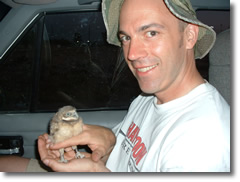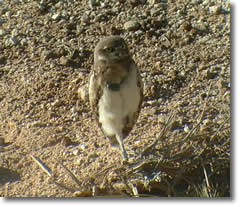Mark Ogonowski
mogo@email.arizona.edu
Background:
I received an M.S. degree in Natural Resources with a specialization in Wildlife and Fisheries Sciences in December 2007 from the School of Natural Resources, where Dr. Conway was my principal advisor. I now work as a Wildlife Biologist in Dr. Conway’s lab where I currently work on various burrowing owl research projects. My interests include avian behavioral ecology, conservation biology, and the consequences of land use change for threatened and sensitive species. I came to The University of Arizona from Massachusetts where I worked for many years as a researcher and teacher developer in the field of science education. I received a B.S. in Biology and later an M.A.in Child Development from Tufts University, and have worked as a research technician in a neuroscience lab and taught elementary school in other past lives. My long-term goal is to promote science-based wildlife conservation while continuing to contribute to public scientific literacy as a conservation biologist.
While a Master’s student I contributed to a long-term demographic study of western burrowing owls (Athene cunicularia hypugaea) in two areas of southern Arizona: on Davis-Monthan Air Force Base and along reaches of the Santa Cruz River in urban Tucson, and on Casa Grande Ruins National Monument and surrounding agricultural areas of Coolidge. Burrowing owls appear to be declining throughout much of the northern and eastern areas of their range, making them a good focus for proactive conservation efforts. A better understanding of the ecology and demographic constraints of this species may help to ensure its viability before reaching threatened or endangered status. I was also fortunate to receive a grant from the Arizona Bird Conservation Initiative and several graduate fellowships and scholarships to support my Master’s project examining burrowing owl migratory behavior.
My thesis research focused on the factors influencing migratory tendency of burrowing owls in urban and agricultural areas of southern Arizona. Populations in our area appear to be partially migratory, and as with many other partial migrants, the factors which cause some individuals to remain during winter while others migrate are unknown. I examined the effect of food abundance, burrow availability, annual fecundity, sex, body size and age on winter residency, including an experiment in which I provided supplemental food to a randomly chosen group of nesting adults. We found that a number of factors influenced migratory tendency of burrowing owls. Supplemental food affected the migratory behavior of burrowing owls but the effect varied by sex: food supplemented males were slightly less likely to migrate, as we predicted, while food supplemented females were more likely to migrate. Owls of both sexes were less migratory at our agricultural study site, females were significantly more likely to migrate than males at the urban site, and the probability of migrating was negatively related to body size. Annual fecundity was negatively related to the probability of migrating for owls fledging at least 1 owlet at both study sites. The number of satellite burrows was positively related to the probability of migrating in Coolidge, but negatively related to the probability of migrating in Tucson. Finally, we examined the association of migratory tendency of adult owls and their offspring, and found no evidence that migratory tendency is a heritable trait.
This study represents one of the first experimental investigations of the factors governing avian migratory tendency and our results have implications for the conservation of western burrowing owls. Populations appear to be declining in northern and eastern areas of their range but stable or increasing in some human-dominated landscapes where food abundance is presumably high year-round, so it is possible that formerly migratory owls are becoming established as year-round residents in these areas (the “altered migration hypothesis”). Our results lend some support to the altered migration hypothesis as an explanation of burrowing owl population trends, and illustrate that the migratory tendency of individuals can be influenced by environmental conditions. These findings are relevant to burrowing owl management at the continental scale, given that the persistence of agricultural habitats may be threatened by urban and suburban development and the growing demand for water in the west. Our findings should also contribute to the conservation of other species of birds whose migratory patterns have changed in recent decades, given that altered resource abundance has typically been implicated as a principal cause of altered migratory behavior.


- Ogonowski, M. S. and C. J. Conway. 2006. Migratory status and factors influencing winter residency of burrowing owls in southern Arizona. Final Report submitted to the Arizona Bird Conservation Initiative, Arizona Game and Fish Department, June 2006.
- Ogonowski, M. S. and C. J. Conway. 2008. Factors influencing migratory tendency of western burrowing owls. Annual Conference of the Western Section of The Wildlife Society. Redding , CA , 6 February 2008
- Ogonowski, M. S. and C. J. Conway. 2007. Is migrating a matter of choice? Migratory behavior of western burrowing owls in southern Arizona . Annual Meeting of The Wildlife Society, Tucson , AZ , 24 September 2007 .
- Ogonowski, M., and C. J. Conway. 2007. To migrate, or not? Factors influencing winter residency in western burrowing owls. 40th Joint Annual Meeting of the Arizona/New Mexico Chapters of The Wildlife Society and American Fisheries Society. Albuquerque, NM, 8 February 2007
- Ogonowski, M., and C. J. Conway. 2006. Factors influencing winter residency of burrowing owls in southern Arizona. North American Ornithological Conference, Veracruz, Mexico, 6 October 2006.
- Ogonowski, M., and C. J. Conway. 2005. Ecology and Migratory Behavior of Burrowing Owls in southern Arizona. Annual Cooperator's Meeting, Arizona Cooperative Fish and Wildlife Research Unit. Tucson, AZ. 29 March 2005.
- 2006-07 NSF CATTS GK-12 Graduate Fellowship from the University of Arizona helping provide professional development for middle school science teachers.
- 2005 & 2006 Silliman Memorial Research Award in Ornithology, The University of Arizona.
- 2004-07 STAR (Science to Achieve Results) Graduate Fellowship from the U.S. Environmental Protection Agency.
- 2004 Budweiser National Conservation Scholarship from the National Fish and Wildlife Foundation